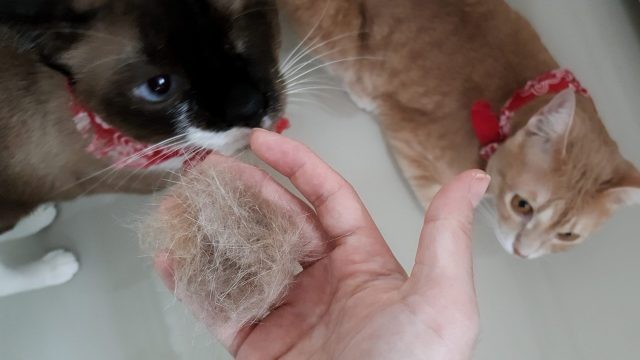Why Does My Cat Eat Hair? This is a common question among cat owners, and understanding the underlying reasons is crucial for your feline companion’s health and well-being. At WHY.EDU.VN, we provide comprehensive explanations and expert insights into this peculiar behavior, helping you address the root causes such as pica, anxiety, or nutritional deficiencies, and ensure your cat’s health. Explore potential health issues, digestive problems, and strategies for enrichment and dietary adjustments.
1. Understanding Why Cats Eat Hair: The Basics
Cats are known for their fastidious grooming habits, spending a significant portion of their day meticulously cleaning their fur. This behavior often leads to the ingestion of loose hair. While some hair ingestion is normal, excessive consumption can indicate underlying issues. Let’s delve into the common reasons behind this behavior and explore solutions to mitigate potential health risks.
1.1. Normal Grooming Behavior
Cats are naturally inclined to groom themselves to maintain cleanliness and regulate body temperature. Their tongues are covered in tiny, backward-facing barbs called papillae, which act like a natural comb. These papillae effectively trap loose hair, which is then swallowed during grooming.
- Purpose of Grooming: Maintaining hygiene, removing parasites, and distributing natural oils.
- Normal Hair Ingestion: A small amount of ingested hair usually passes through the digestive system without causing problems.
- Hairballs: Excessive hair ingestion can lead to the formation of hairballs in the stomach, which the cat may vomit or pass through the digestive tract.
1.2. Hairballs: A Common Consequence
Hairballs are a frequent issue for cats, particularly those with long fur. When a cat swallows hair, it can accumulate in the stomach, forming a dense, felt-like mass. These hairballs can cause discomfort and, in some cases, lead to more severe health issues.
- Formation: Hair accumulates in the stomach and is not easily digested.
- Symptoms: Vomiting, gagging, constipation, and loss of appetite.
- Management: Regular grooming, specialized diets, and hairball remedies can help manage hairballs.
2. Potential Reasons for Excessive Hair Consumption
While normal grooming explains some hair ingestion, excessive consumption can be a sign of underlying issues. It’s important to identify the potential reasons to address the behavior effectively.
2.1. Pica: An Eating Disorder
Pica is an eating disorder characterized by the persistent consumption of non-food items. In cats, this can manifest as eating hair, fabric, plastic, or other unusual materials.
- Definition: Compulsive eating of non-nutritive substances.
- Causes: Nutritional deficiencies, boredom, stress, or underlying medical conditions.
- Diagnosis: Requires a thorough veterinary examination, including blood tests and possibly imaging.
- Treatment: Addressing underlying medical issues, providing a balanced diet, and managing behavioral factors.
2.2. Nutritional Deficiencies
A lack of essential nutrients in a cat’s diet can sometimes lead to pica. The cat may be attempting to compensate for these deficiencies by eating non-food items like hair.
- Common Deficiencies: Vitamins, minerals, or fiber.
- Dietary Assessment: Consult with a veterinarian to evaluate your cat’s diet and identify any deficiencies.
- Dietary Adjustments: Switching to a high-quality, balanced diet can help resolve nutritional deficiencies.
2.3. Boredom and Attention-Seeking
Cats that are bored or seeking attention may engage in unusual behaviors, including eating hair. This can be a way to stimulate themselves or elicit a response from their owners.
- Signs of Boredom: Lack of interest in toys, excessive sleeping, and destructive behavior.
- Enrichment Strategies: Providing interactive toys, scratching posts, and climbing structures can help alleviate boredom.
- Attention: Spend quality time playing and interacting with your cat to meet their social needs.
2.4. Stress and Anxiety
Stress and anxiety can manifest in various behavioral changes in cats, including excessive grooming and the consumption of hair. Identifying and addressing the sources of stress is crucial.
- Common Stressors: Changes in environment, new pets, loud noises, or separation anxiety.
- Signs of Anxiety: Hiding, excessive meowing, changes in appetite, and aggression.
- Management: Providing a safe and predictable environment, using pheromone diffusers, and consulting with a veterinarian or behaviorist.
2.5. Underlying Medical Conditions
In some cases, eating hair can be a symptom of an underlying medical condition, such as gastrointestinal issues or hormonal imbalances.
- Gastrointestinal Problems: Inflammatory bowel disease (IBD) or malabsorption can lead to unusual eating behaviors.
- Hormonal Imbalances: Hyperthyroidism can increase appetite and lead to pica.
- Diagnostic Tests: Blood tests, fecal exams, and imaging may be necessary to diagnose underlying medical conditions.
- Treatment: Addressing the underlying medical condition is essential to resolving the hair-eating behavior.
3. Identifying the Root Cause
Determining the exact reason your cat is eating hair involves careful observation and, if necessary, veterinary consultation.
3.1. Observe Your Cat’s Behavior
Pay close attention to when and how your cat eats hair. Note any patterns or triggers that seem to coincide with the behavior.
- When Does It Occur?: After grooming, when bored, or during stressful situations?
- How Often?: Is it an occasional habit or a frequent occurrence?
- What Else Is Your Cat Doing?: Are there other unusual behaviors, such as excessive grooming or hiding?
3.2. Consult with a Veterinarian
If you’re concerned about your cat’s hair-eating behavior, consult with a veterinarian. They can perform a physical examination and run diagnostic tests to rule out medical causes.
- Physical Examination: Assessing overall health and looking for signs of underlying medical conditions.
- Blood Tests: Checking for nutritional deficiencies, hormonal imbalances, and organ function.
- Fecal Exam: Ruling out parasites or gastrointestinal issues.
- Imaging: X-rays or ultrasounds may be used to examine the digestive tract.
3.3. Evaluate Diet and Environment
Assess your cat’s diet and environment to identify potential contributing factors.
- Diet: Is your cat eating a high-quality, balanced diet?
- Environment: Is your cat’s environment stimulating and stress-free?
- Changes: Have there been any recent changes in your cat’s diet or environment?
4. Solutions and Strategies to Stop Hair Eating
Once you’ve identified the potential reasons for your cat’s hair-eating behavior, you can implement strategies to address the issue.
4.1. Dietary Adjustments
Ensure your cat is receiving a balanced and complete diet to address any potential nutritional deficiencies.
- High-Quality Food: Choose a cat food that is formulated to meet your cat’s specific nutritional needs.
- Fiber Supplementation: Adding fiber to your cat’s diet can help improve digestive health and reduce the urge to eat non-food items.
- Omega-3 Fatty Acids: Supplementing with omega-3 fatty acids can help improve skin and coat health, reducing shedding and hair ingestion.
4.2. Enrichment and Play
Provide plenty of opportunities for play and enrichment to alleviate boredom and reduce stress.
- Interactive Toys: Puzzle feeders, laser pointers, and feather wands can provide mental stimulation and physical exercise.
- Scratching Posts: Provide multiple scratching posts to encourage natural scratching behavior and reduce stress.
- Climbing Structures: Cats enjoy climbing, so provide cat trees or shelves to allow them to explore and feel secure.
4.3. Stress Reduction
Create a calm and predictable environment to minimize stress and anxiety.
- Safe Spaces: Provide quiet, comfortable places where your cat can retreat when feeling overwhelmed.
- Pheromone Diffusers: Use pheromone diffusers like Feliway to create a calming environment.
- Consistent Routine: Maintain a consistent feeding and play schedule to provide a sense of security.
4.4. Regular Grooming
Regular grooming can help reduce the amount of loose hair your cat ingests.
- Brushing: Brush your cat daily to remove loose hair and prevent it from being swallowed.
- Professional Grooming: Consider professional grooming for long-haired cats to help manage shedding.
- Bathing: Occasional baths can help remove loose hair and improve skin health.
4.5. Hairball Remedies
Use hairball remedies to help your cat pass ingested hair more easily.
- Hairball Food: These diets are formulated with higher fiber content to help move hair through the digestive system.
- Hairball Treats: These treats contain lubricants that help hair pass through the digestive tract.
- Petroleum Jelly: A small amount of petroleum jelly can be given orally to help lubricate the digestive tract.
4.6. Environmental Management
Remove or restrict access to items your cat is eating.
- Remove Hair: Regularly clean up loose hair from floors, furniture, and clothing.
- Store Items Securely: Keep potentially harmful items out of reach.
5. When to Seek Professional Help
While many cases of hair-eating can be managed at home, some situations require professional intervention.
5.1. Persistent Behavior
If your cat continues to eat hair despite your best efforts, consult with a veterinarian or veterinary behaviorist.
- Veterinary Behaviorist: A specialist in animal behavior can help identify the underlying causes of the behavior and develop a customized treatment plan.
- Medication: In some cases, medication may be necessary to manage anxiety or compulsive behaviors.
5.2. Medical Symptoms
If your cat exhibits any of the following symptoms, seek immediate veterinary care:
- Vomiting
- Diarrhea
- Constipation
- Loss of Appetite
- Lethargy
5.3. Suspected Pica
If you suspect your cat has pica, consult with a veterinarian for a thorough evaluation and treatment plan.
- Comprehensive Assessment: Includes physical examination, blood tests, and behavioral assessment.
- Treatment Plan: May involve dietary changes, environmental enrichment, and behavioral modification techniques.
6. The Role of WHY.EDU.VN in Answering Your Questions
At WHY.EDU.VN, we understand the challenges cat owners face when trying to understand and address unusual behaviors like hair eating. Our platform provides a wealth of information, expert advice, and a supportive community to help you navigate these challenges.
6.1. Expert Insights
Our team of experts includes veterinarians, animal behaviorists, and experienced cat owners who provide accurate and up-to-date information.
- Reliable Information: We ensure all our content is thoroughly researched and reviewed by professionals.
- Practical Advice: We offer practical, actionable advice that you can implement at home.
- Comprehensive Coverage: We cover a wide range of topics related to cat health, behavior, and care.
6.2. Community Support
Our platform provides a community forum where you can connect with other cat owners, share experiences, and ask questions.
- Shared Experiences: Learn from other cat owners who have faced similar challenges.
- Supportive Environment: Receive encouragement and support from a community that understands your concerns.
- Expert Answers: Get answers to your questions from our team of experts.
6.3. Easy Access to Information
WHY.EDU.VN is designed to provide easy access to the information you need.
- User-Friendly Interface: Our website is easy to navigate, making it simple to find the information you’re looking for.
- Search Functionality: Use our search function to quickly find answers to specific questions.
- Mobile-Friendly: Access our website on your smartphone or tablet for on-the-go information.
7. Latest Research and Studies
Staying informed about the latest research and studies can help you make the best decisions for your cat’s health and well-being.
7.1. Pica in Cats
Recent studies have shed light on the causes and treatment of pica in cats.
- Nutritional Factors: Research suggests that certain nutritional deficiencies, such as iron or zinc, may contribute to pica.
- Behavioral Factors: Studies have also explored the role of stress and anxiety in pica behavior.
- Treatment Approaches: Researchers are investigating the effectiveness of various treatment approaches, including dietary changes, environmental enrichment, and medication.
7.2. Hairball Management
New advances in hairball management have led to more effective products and strategies.
- High-Fiber Diets: Studies have shown that high-fiber diets can help reduce hairball formation by promoting healthy digestion.
- Lubricant Products: New lubricant products are designed to help hair pass through the digestive tract more easily.
- Grooming Techniques: Research has explored the most effective grooming techniques for reducing shedding and hair ingestion.
7.3. Stress and Anxiety in Cats
Understanding the causes and management of stress and anxiety in cats is crucial for preventing behavioral issues like hair eating.
- Environmental Enrichment: Studies have shown that providing cats with a stimulating environment can help reduce stress and anxiety.
- Pheromone Therapy: Research has demonstrated the effectiveness of pheromone diffusers in calming anxious cats.
- Behavioral Modification: Behavioral modification techniques can help cats cope with stressful situations.
8. Practical Tips for Cat Owners
Here are some practical tips to help you manage your cat’s hair-eating behavior and promote their overall well-being.
8.1. Regular Veterinary Check-Ups
Schedule regular veterinary check-ups to monitor your cat’s health and identify any potential issues early on.
- Annual Exams: Annual exams allow your veterinarian to assess your cat’s overall health and screen for underlying medical conditions.
- Vaccinations: Keep your cat up-to-date on their vaccinations to protect them from infectious diseases.
- Parasite Control: Use preventative medications to protect your cat from fleas, ticks, and intestinal parasites.
8.2. Create a Safe and Stimulating Environment
Provide a safe and stimulating environment to promote your cat’s physical and mental well-being.
- Safe Indoor Space: Ensure your cat has a safe and comfortable indoor space where they can retreat when feeling overwhelmed.
- Vertical Space: Provide cat trees or shelves to allow your cat to climb and explore.
- Window Perches: Offer window perches where your cat can watch birds and other outdoor activities.
8.3. Monitor Litter Box Habits
Pay attention to your cat’s litter box habits, as changes in urination or defecation can be signs of underlying health issues.
- Consistency: Use the same type of litter and maintain a consistent cleaning schedule.
- Frequency: Monitor how often your cat urinates and defecates.
- Changes: Contact your veterinarian if you notice any changes in your cat’s litter box habits.
8.4. Provide Fresh Water
Ensure your cat always has access to fresh, clean water.
- Multiple Bowls: Place multiple water bowls around your home to encourage your cat to drink.
- Water Fountain: Consider using a cat water fountain, as many cats prefer running water.
- Cleanliness: Clean water bowls daily to prevent bacterial growth.
8.5. Positive Reinforcement
Use positive reinforcement techniques to encourage good behavior and discourage unwanted behaviors.
- Treats: Reward your cat with treats for good behavior.
- Praise: Offer verbal praise and petting to reinforce positive actions.
- Avoid Punishment: Avoid using punishment, as it can create fear and anxiety.
9. Addressing Common Misconceptions
There are several common misconceptions about why cats eat hair. Let’s debunk some of these myths.
9.1. Myth: Cats Eat Hair Because They Are Hungry
Fact: While nutritional deficiencies can contribute to hair eating, it is not always related to hunger. Cats may eat hair due to boredom, stress, or underlying medical conditions.
9.2. Myth: Hair Eating Is Always Harmful
Fact: While excessive hair eating can lead to hairballs and other health issues, some hair ingestion is normal as part of the grooming process.
9.3. Myth: All Cats Will Eventually Eat Hair
Fact: Not all cats engage in hair eating. Some cats are more prone to this behavior than others, depending on factors such as breed, coat length, and individual habits.
9.4. Myth: There Is Nothing You Can Do About Hair Eating
Fact: There are many strategies you can use to manage your cat’s hair-eating behavior, including dietary changes, environmental enrichment, and regular grooming.
10. FAQ: Common Questions About Cats Eating Hair
Here are some frequently asked questions about why cats eat hair.
10.1. Is It Normal for My Cat to Eat Hair?
Yes, some hair ingestion is normal as part of the grooming process. However, excessive hair eating can be a sign of underlying issues.
10.2. Why Is My Cat Suddenly Eating Hair?
Sudden changes in behavior can be caused by stress, anxiety, or underlying medical conditions. Consult with your veterinarian to rule out any medical causes.
10.3. How Can I Stop My Cat from Eating Hair?
You can try dietary adjustments, environmental enrichment, regular grooming, and hairball remedies.
10.4. Is Hair Eating a Sign of Pica?
Yes, hair eating can be a sign of pica, especially if your cat is eating other non-food items.
10.5. What Are the Risks of Hair Eating?
The risks of hair eating include hairballs, vomiting, constipation, and potential intestinal blockages.
10.6. When Should I See a Vet About My Cat Eating Hair?
You should see a vet if your cat is exhibiting symptoms such as vomiting, diarrhea, loss of appetite, or lethargy.
10.7. Can Diet Help with Hair Eating?
Yes, a balanced and complete diet can help address nutritional deficiencies that may be contributing to hair eating.
10.8. How Can I Reduce Hairballs in My Cat?
You can reduce hairballs by grooming your cat regularly, providing a high-fiber diet, and using hairball remedies.
10.9. Is Stress a Factor in Hair Eating?
Yes, stress and anxiety can contribute to hair eating.
10.10. What Is the Best Way to Groom My Cat to Prevent Hair Eating?
Brush your cat daily to remove loose hair and prevent it from being swallowed.
Understanding why your cat eats hair requires careful observation, veterinary consultation, and a proactive approach to managing their diet, environment, and overall well-being. At WHY.EDU.VN, we are committed to providing you with the knowledge and resources you need to ensure your feline companion leads a happy and healthy life.
Are you still curious about your cat’s peculiar habits? Do you need more personalized advice on how to address their hair-eating behavior? Don’t hesitate to reach out to our experts at why.edu.vn. Visit our website or contact us at 101 Curiosity Lane, Answer Town, CA 90210, United States, or via Whatsapp at +1 (213) 555-0101. Let us help you uncover the answers you seek!


